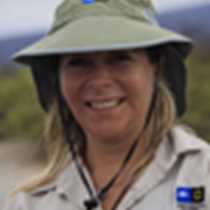Espanola Island
Espanola Island is the jewel of the crown in the enchanted islands. What a great farewell to one of the best trips of our lives!
We had a super exciting morning to start our last day in the islands. Landing on the beach at Gardner Bay was a real adventure. Six- to seven-foot high swells were pretty spectacular and made this wet landing the most thrilling of the whole week. We had a lot of fun on the white sandy beach, sharing these precious moments with several hundreds of sea lions that were incredibly careless about us and basking in the sun. Ocean kayakers had a great time surfing the big swells in the middle of the blue waters of the Pacific.
Of course another huge highlight of the day was the afternoon visit to the location of Punta Suarez on Espanola Island, the oldest island of the archipelago above the water surface. This is one of the reasons why this island has a lot of very ancient, unique and endemic species. More than half of the species we see here are endemic to this specific island. Punta Suarez has the largest number of wildlife per square inch than any of the visiting sites we’ve seen during this week.
We landed on a rocky pier and met our welcome committee: big red Sally Lightfoot crabs, green and red marine iguanas, baby sea lions together with males and females, huge lava lizards, pelicans, blues footed boobies, Nazca boobies and more.
Because of the big swells, the enormous blow hole was unusually powerful and exhilarating. We walked half the way on the rocky boulders. The fabulous view of the high cliffs… It was all a huge delight.
The only thing that we missed for a couple of weeks is the waved Albatross. About 19,000 pairs come only to the island of Espanola to nest. They are very much on time. After spending all their time at sea, they come to this island at the very end of April to nest. They dance, they court, they lay their eggs, they carefully incubate them and, once their offspring is ready, they all leave to the sea again at the end of January
So long Galápagos.
Espanola Island is the jewel of the crown in the enchanted islands. What a great farewell to one of the best trips of our lives!
We had a super exciting morning to start our last day in the islands. Landing on the beach at Gardner Bay was a real adventure. Six- to seven-foot high swells were pretty spectacular and made this wet landing the most thrilling of the whole week. We had a lot of fun on the white sandy beach, sharing these precious moments with several hundreds of sea lions that were incredibly careless about us and basking in the sun. Ocean kayakers had a great time surfing the big swells in the middle of the blue waters of the Pacific.
Of course another huge highlight of the day was the afternoon visit to the location of Punta Suarez on Espanola Island, the oldest island of the archipelago above the water surface. This is one of the reasons why this island has a lot of very ancient, unique and endemic species. More than half of the species we see here are endemic to this specific island. Punta Suarez has the largest number of wildlife per square inch than any of the visiting sites we’ve seen during this week.
We landed on a rocky pier and met our welcome committee: big red Sally Lightfoot crabs, green and red marine iguanas, baby sea lions together with males and females, huge lava lizards, pelicans, blues footed boobies, Nazca boobies and more.
Because of the big swells, the enormous blow hole was unusually powerful and exhilarating. We walked half the way on the rocky boulders. The fabulous view of the high cliffs… It was all a huge delight.
The only thing that we missed for a couple of weeks is the waved Albatross. About 19,000 pairs come only to the island of Espanola to nest. They are very much on time. After spending all their time at sea, they come to this island at the very end of April to nest. They dance, they court, they lay their eggs, they carefully incubate them and, once their offspring is ready, they all leave to the sea again at the end of January
So long Galápagos.



